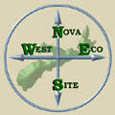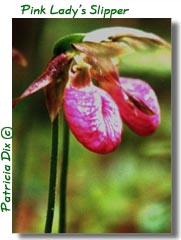

Mountain Avens (Grem peckii)

Prior to 1997 this plant was thought only to exist on Brier Island, blooming in July and August in bogs. However a colony of approximately 2000 was discovered growing on the main land in the Digby Neck area. The Mountain Aven is one of our most endangered plants and appears on COSEWIC's (Committee On the Status of Endangered Wildlife In Canada) endangered list, for its protection the exact locations of these plants are not given.
Northern Pitcher Plant (Sarracenia purpurea)
Found in bogs and bog meadows the Northern Pitcher plant is insectivorous. The tubular shape of the leaves holds water that the plant uses to trap insects. These insects are then digested supplying nutrients otherwise not available to the plant due to the poor soil conditions. These plants range from 20 cm-60 cm in height with a large solitary purple flower node at the top of the stock, that comes into bloom between June and July.
Water-pennywort (Hydrocotyle umbellata)
The water-pennywort is currently on the COSEWIC's endangered list. The plant is fairly rare and if you are lucky enough to see some please take great caution not to inadvertently damage them. Water-pennywort is generally found on south facing lakes along a rocky shore line between the high and low water marks. By growing in an area that experiences seasonal flooding, the Water-pennywort ensures that it has less competition for space.
Lady's Slipper (Cypripedium acaule)
Lady's Slipper is a member of the Orchid family and can be found in wooded areas with a dry to moist acidic soil. They bloom in June, bearing a single pink moccasin shaped flower and range in size from 10 cm to 50 cm.
Skunk Cabbage (Sympiocarpus foetidus)
As you may have gathered from the name, the Skunk Cabbage releases a rancid odour when it blooms in late April to early May. The bloom resembles carrion both in odour and appearance. This odour is used to attract pollinators. Found in bogs this early blooming flower generates its own heat, melting the overlying snow and allowing the plant to grow up through the opening. Temperatures within buds have been recorded as 27
degrees F. warmer than that of the outside air. This plant can be viewed from the boardwalk of the Balancing Rock trail. The plant can reach 30-60 cm in height and with its large bright green leaves which can reach a size of 60 cm, the Skunk Cabbage has an almost tropical appearance. These leaves will die as a result of frost as fall progresses, leaving a flower covered by a hood-like leaf. This plant is considered rare due to its confinement to South Western Nova Scotia.
Harebell (Campanula rotundifolia)
This plant is found along the shore in the Bay of Fundy. Blooming from June to October this delicate plant has a blue, bell shaped flower on a slender stem. While the majority of these have blue flowers, some white Harebells can be found along the Delap's Cove Wilderness Trail.
May Flower (Epigaea repen)
The May Flower is Nova Scotia's provincial flower and can be seen in bloom from mid April to mid May. Growing in mixed woodlands with a well drained acidic soil, these plants low growing plants a beautiful find.
[Home
| News | Ecotourism
]
[ Eco Solutions | Regional
Map | Tourist Info]









